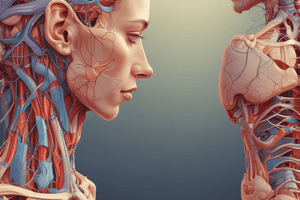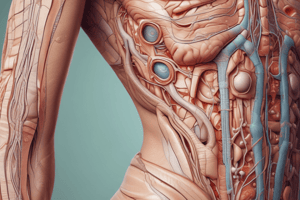Podcast
Questions and Answers
What is the main component of the outermost layer of the epidermis?
What is the main component of the outermost layer of the epidermis?
- Live cells containing collagen
- Dead cells containing keratin (correct)
- Live cells containing keratin
- Dead cells containing collagen
What inhibits the growth of many microorganisms in perspiration?
What inhibits the growth of many microorganisms in perspiration?
- Antimicrobial peptides
- Lysozyme
- Salt (correct)
- Sebum
What is the primary function of sebum secreted by oil glands?
What is the primary function of sebum secreted by oil glands?
- Breaks down the cell walls of bacteria
- Prevents skin and hair from drying out (correct)
- Promotes the growth of certain pathogens
- Provides energy for microbial growth
What provides moisture and some nutrients for microbial growth on the skin?
What provides moisture and some nutrients for microbial growth on the skin?
Which part of the skin provides passageways for microorganisms to enter and penetrate deeper tissues?
Which part of the skin provides passageways for microorganisms to enter and penetrate deeper tissues?
What is the primary function of the stratum corneum in the epidermis?
What is the primary function of the stratum corneum in the epidermis?
What is the main purpose of sebum secreted by oil glands?
What is the main purpose of sebum secreted by oil glands?
What inhibits many microorganisms in perspiration?
What inhibits many microorganisms in perspiration?
What provides passageways for microorganisms to enter and penetrate deeper tissues in the skin?
What provides passageways for microorganisms to enter and penetrate deeper tissues in the skin?
What is the composition of sebum secreted by oil glands?
What is the composition of sebum secreted by oil glands?
Study Notes
Skin Composition and Function
- The main component of the outermost layer of the epidermis is the stratum corneum.
- Perspiration, which is salty and acidic, inhibits the growth of many microorganisms.
- Sebum secreted by oil glands has a primary function of providing moisture and some nutrients for microbial growth on the skin.
- The primary function of sebum secreted by oil glands is to provide moisture and some nutrients for microbial growth on the skin.
- Sweat glands and hair follicles provide passageways for microorganisms to enter and penetrate deeper tissues in the skin.
- The primary function of the stratum corneum in the epidermis is to provide a barrier against environmental stressors.
- Perspiration, which is salty and acidic, inhibits many microorganisms, thereby preventing infection.
- Sebum secreted by oil glands is composed of a mixture of lipids, including triglycerides, wax esters, and squalene.
Studying That Suits You
Use AI to generate personalized quizzes and flashcards to suit your learning preferences.
Description
Test your knowledge of microbial diseases affecting the skin and eyes with this quiz. Learn about the structure and function of the skin as you explore the epidermis and dermis. Understand the layers of epithelial cells and their role in protecting the body from pathogens.




